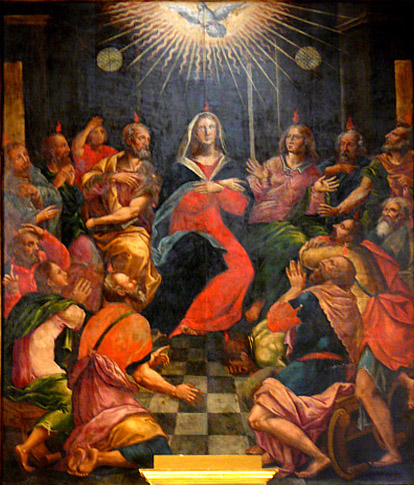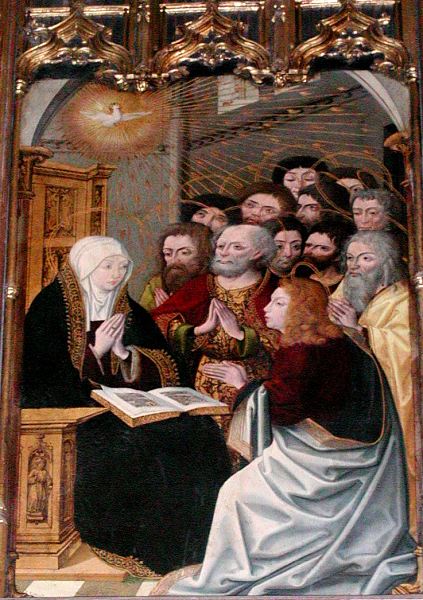The painting shown at right is typical of most Pentecost images. The Apostles are seated, and the tongues of fire sit on their heads, imparted by the Holy Spirit, who is imaged as a dove giving forth rays of light.
Until the 12th century the images presented only the Apostles, as in the second picture at right. Even in the 13th the Golden Legend leaves the Virgin out of the picture: "As to…into whom he [the Holy Spirit] was sent, into the apostles, that were clean and pure and disposed to receive the Holy Ghost." In these earlier images the central figure will be St. Peter, as at right, or Peter and Paul, as in the Berthold Sacramentary and the Pentecost Cupola at St. Marks in Venice.1 The latter is unusual in that it adds the "Parthians, Medes," etc., who heard the Apostles each in their own language (2:9-11).
Beginning in the 12th century Pentecost images more and more frequently put the Virgin Mary in the center of the image among the Apostles (example). Often St. Peter will be on her right and St. John on her left, as in the first picture at right. Mary is not mentioned in scriptural accounts of the Ascension, but medieval commentators explained she was there as a type of the Church.2 Pentecost has been considered the "birthday" of the Church. The Pentecost panels in an English stained-glass window make this point by juxtaposing the event with three images relating to the introduction of the ecclesial structures of the Old Law.
By the end of the Middle Ages her presence is just about mandatory, especially with the development of the Rosary prayer. This comprises 15 "decades" of prayers memorializing 15 "mysteries" or moments in Mary's life. The 13th of these is "The Descent of the Holy Ghost Upon the Apostles and the Virgin Mary." This image is an example of the many artworks that presented the 15 mysteries and included Mary among the Apostles as the 14th.
Usually Mary is at the center of the group, and she is often singled out for special emphasis, as in the third picture at right, where the apostles kneel to her and the dove hovers over her alone.
Most images show no other figures besides the Virgin and the Apostles, but one from the 15th century adds Mary Magdalene and several include a crowd that I imagine represents the 120 "brethren" of Acts 1:15 (example). In the images with crowds the people are outdoors, but otherwise some care is usually taken to emphasize that the participants are in a room.
Artists rarely try to suggest the "mighty wind." An exception is an illumination in the Berthold Sacramentary (13th century), where allegorical figures at the four corners pour winds from large jars.3
Prepared in 2015 by Richard Stracke, Emeritus Professor of English, Augusta University
HOME PAGE

From the Church of St. Fleuret, Estaing, France (See description page)

In this 12th-century enamel the Father and Son, represented symbolically, send down the Holy Spirit. (See description page)

Pamplona Cathedral, Spain, 1507 (See description page)
MORE IMAGES
- 1344: This late example of a Pentecost centered on St. Peter rather than Mary is from Guariento di Arpo's Coronation of the Virgin altarpiece.
- Early 16th century: Relief sculpture in Oviedo, Spain
- Undated: This sculpture explicitly pictures the Father and Son sending down in the Holy Spirit.
DATES
- Pentecost is a "moveable feast," celebrated fifty days after Easter Sunday.
NAMES
- The traditional British name for the feast is Whitsun or Whitsunday. Most Romance languages are like American English in simply adapting the Latin Pentecostes.
ALSO SEE
- The Ascension
- Golden Legend chapter 73, "Pentecost"
NOTES
1 For the Berthold Sacramentary see the Web Gallery of Art (search for "Pentecost" and "1201-1250") or go directly to this photo of the image (retrieved 2015-01-10 from the Web Gallery of Art).
2 To this effect Mâle, Religious Art in France of the Thirteenth Century, 194, cites Honorius of Autun's Speculum Ecclesiae, whose commentary on the Ascension has O quam sereno vultu in ordine suo stetit dum [cum?] apostolicum chorum, qui ejus ordo extitit, et per Virginem Dei Genitricem, quae ejus typum gessit, carnem suam in capite suo, id est in Redemptore suo, in Sponso suo, in Deo suo, aethera penetrare conspexit! (col. 955). As for the testimony of scripture, Acts 1:13 says that during the days after the Ascension the Apostles prayed in the upper room "with the women, and Mary the mother of Jesus, and with his brethren," but it does not actually say that Mary was there for the Pentecost event on the tenth day. Nor does Mary figure in any of the three scriptural accounts of the Ascension (Mark 16:19, Luke 24:51, Acts 2:9).
3 For the Berthold Sacramentary see above, note 1.